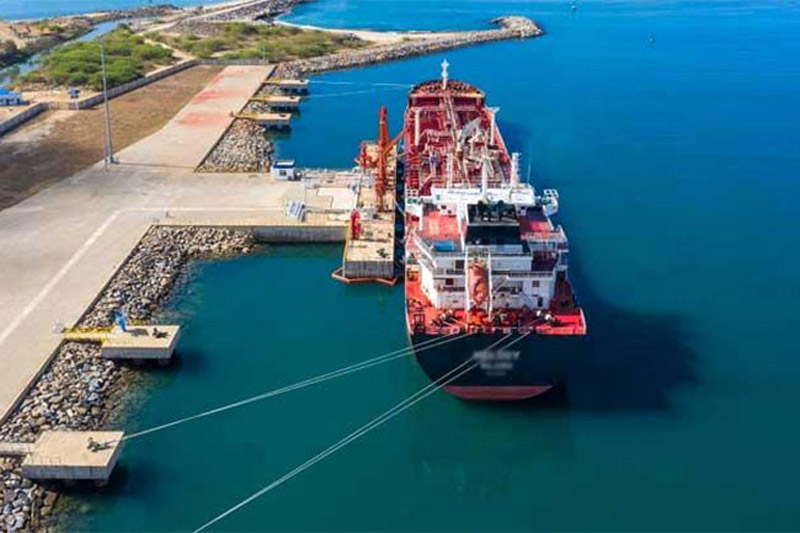In the wake of vessel re-routings aimed at avoiding
the Red Sea, bunker demand across ports in both India and Sri Lanka has witnessed a significant surge, highlighting a growing challenge for the maritime industry. While India contends with supply shortages, Sri Lankan ports are experiencing a notable increase in activity.
According to S&P Global Commodity Insights, the demand spike, estimated to be over 30 per cent in ports across India and Sri Lanka, has been primarily attributed to longer voyages undertaken by ship owners and charters to circumvent the Red Sea region. Consequently, ports on India’s west coast, particularly Kochi and Mumbai, are grappling with disrupted VLSFO (Very Low Sulfur Fuel Oil) supplies, exacerbating the situation.
Despite the increased demand, price movements in the bunker fuel market have been mixed as of March 28. Platts, a division of S&P Global Commodity Insights, reported that while 0.5 per cent marine fuel oil delivered to Kochi saw a USD 20/mt increase to USD 700/mt CFR, prices in Mumbai fell to USD 698/mt, down by USD 8/mt. Similarly, in Sri Lanka, prices at Colombo were assessed at USD 700/mt, reflecting a decrease of USD 7/mt on the week.
A trader based in Gujarat highlighted the substantial rise in demand, and told S&P Global, “Demand has substantially increased, almost by 30 per cent across Mumbai, Kochi and Gujrat ports. Long haul vessels are calling more often now. The volumes that were being lifted at King Abdullah port, Yanbu, Djibouti and Suez Canal have now shifted to Indian and Sri Lankan Ports.” Echoing this sentiment, a supplier based in Kandla noted, “Longer voyages coupled with a shortage of VLSFO at some Indian ports has increased demand at Kandla and Mundra.”
The supply crunch at Indian ports, particularly Kochi, has further bolstered demand at Sri Lankan ports like Colombo and Hambantota. A Bunkerworld survey revealed a significant surge in bunker sales volume at Colombo, reaching 40,000 mt/month, up from an average of 30,000 mt/month prior to the disruptions in the Red Sea region.
Despite the increased demand, Sri Lankan ports remain well supplied through consistent inflows from Fujairah and Singapore. A supplier from Kochi highlighted the market conditions, stating, “For VLSFO the queries have reduced a lot as the market knows we’re out of product. Whatever prices are being quoted are only on best endeavor basis (subject to availability).”
He added, “With that condition, both traders and clients do not want to take any risk. We’re not getting any queries for MGO and even if we do it’s only for smaller parcels that would help cover the voyage to cheaper places.” In response to supply shortages in India, traders have redirected their inquiries to Sri Lanka, further driving up demand in the region.
A trader based in Colombo remarked, “Demand has almost doubled since January. Tightness across Indian markets during the first few weeks also helped us to capture the demand. Interestingly, we’re seeing a considerable number of inquiries for HSFO. There are three active high sulfur fuel oil suppliers in the market now.” However, supply constraints persist in India, particularly at major ports like Kochi and Mumbai.
A BPCL official noted the impact of disrupted cargo inflows on VLSFO production, stating, “Kochi remains dry. BPCL does not buy spot purchases, we might have been getting sweet crude cargoes from Mediterranean, but the crisis has disrupted cargo inflows and thus the production of VLSFO has been hit.” Meanwhile, an IOCL official shed light on the challenges faced by refineries, stating, “The IOCL refinery in Gujarat underwent a partial shutdown in February while the demand surged due to the Red Sea. Initially, the refinery was producing in line with market demand.”
He added, “However, we found ourselves actively pursuing traders to understand why demand wasn’t picking up at Kandla port, when demand was low at the time. Consequently, we slightly reduced production.” With the spotlight on India’s bunker fuel production, it’s revealed that the entire production comes from only three refineries, out of which HPCL and BPCL have lowered output.
In Haldia, while demand remains high, supply falls short of requirements due to maintenance issues at the local refinery. The top suppliers of bunker fuels in the Indian market, including IOCL, BPCL, and HPCL, continue to navigate challenges to meet the escalating demand.
Source: ANI
--Agencies

